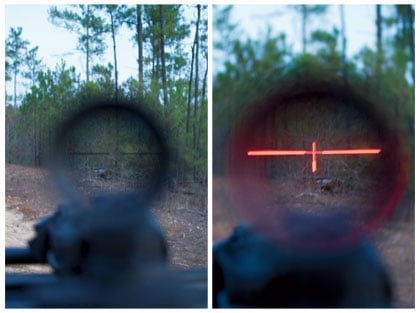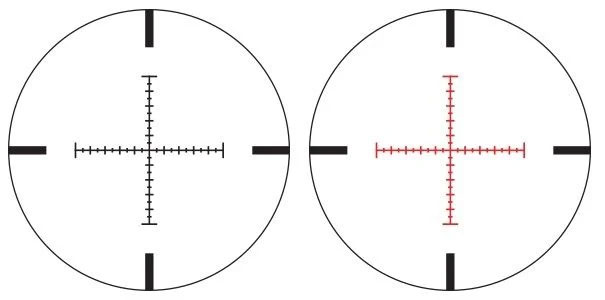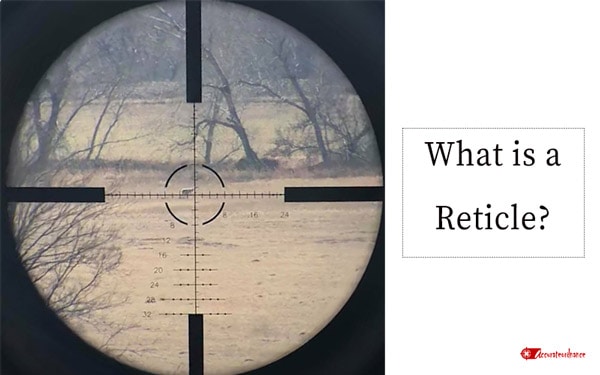
When you’re looking for a new rifle scope, and are tired of the old iron sights, there’s tons of features that you need to consider: magnification range, eye relief, bullet drop compensation, light transmission, focal plane, and even the lens surface coating. But, what about reticle illumination? This one is usually left out of the main points when it’s time to get a new optic. The decision of whether or not to get an illuminated reticle scope is one that might sound completely foreign to a lot of people because it’s not talked about as often as it should be. Today, we’re going to talk all things illuminated reticle scope shooting.
Now, when talking about an illuminated scope, it’s important to realize that there can also be a non illuminated reticle alongside the other illuminated options. So, what exactly is an illuminated scope, and what do you use it for? How does it differ from the non illuminated reticle? Which is the best scope type for you?
What is an Illuminated Reticle?

Sounds like it should be simple, right? Well, there’s actually quite a lot of confusion floating around about what an illuminated scope actually is. It’s literally exact what it sounds like: a rifle scope that has the ability to light up or illuminate the reticle picture that you see through your scope. Now, the way it works can vary, which might be why a lot of people get confused about it. The reticle illumination can be powered from batteries and electrical parts or just ambient light. Technically, you could call a red dot sight an illuminated reticle, but that’s not our point today.
Using electrical workings is definitely the most common route that a lot of scope manufacturers take to produce their illuminated scopes. However, the other method of using ambient light is becoming more and more popular as the firearm market community grows.
If your scope is powered by ambient light, this means that it absorbs light that is around it that it uses to retain a glow once it’s darker. Just think of those glow in the dark toys you had as a kid; how you would stuff them under the lamp and then they would glow? Pretty much the same concept here, just much more technologically advanced.
Both of these methods work just as equally if you use them right. Just remember that your scope, if it needs ambient light to glow, will have to gain light from a brighter artificial source when you’re using it in low light conditions. So, say that you’re out hunting around dawn for the first time in a while. It’s pretty likely that your illuminated reticle won’t be working too well because it doesn’t have any light to absorb. While this can prove to be an inconvenience to a shooter, it doesn’t mean the method can’t work just as well.
What is a Non Illuminated Reticle?

This one is extremely simple. A non illuminated reticle is a scope that contains no ability to light up or glow. This will just be your typical rifle scope. Now, most of today’s modern optics are going to feature an illuminated scope. The market is moving away from the non illuminated and you won’t find these as much anymore when you’re looking for a scope. But, they still do exist, so it’s important to know what they are.
While the illuminated reticles are becoming more and more common, every shooter who knows the difference will usually be on one side or the other. They’ll either say illuminated reticles are amazing, or just hate them entirely. So today, we’re going to clear up some of that confusion and extreme opinions you’ve heard with some hard facts.
Why Use an Illuminated Reticle?

Now, this is what you’re probably asking yourself: why should I even bother with reticle illumination?
Well, an illuminated scope reticle is designed with the idea of keeping your reticle visible against any target, background, or in low light conditions. Here’s another common misconception you’re probably already thinking of: “well, I only shoot during the day time, so this won’t be a problem for me.” However, that’s not really true. Even in the daylight there’s places and environments where your reticle can blend in with the background, if not become impossible to see.
Just think of this example. You spot a great looking deer in the tree line and it’s standing against the dense shrubs and trees in the shadows. The sun is shining behind it, making it look like that perfect shot that you’ve always dreamed up. You bring your rifle up, sight in on the deer, and… nothing. Your reticle is gone! Reasons like this are exactly where a lit reticle would benefit you. Since reticles are typically dark in color, they have a tendency to disappear against darker colors you’re looking at.
Before we move on, let’s make one thing clear. A lit reticle will NOT light up your target. The only thing that will be glowing is the reticle in order for you to be able to see it in all situations. The scope does not just magically turn into a flashlight. It merely lights your reticle or etched glass reticle to make it more visible.
Advantages
There’s plenty advantages to using a lit reticle. For one, you can always rely on your reticle to be visible when you need it most in pretty much any situation. That means low light performance, dark backgrounds, and shadows on your target. All of these and you will still be able to clearly see your reticle to land your perfect shot.
Not only that, but usually the reticle illuminated can be toggled on and off as needed. This way, if you don’t feel like looking at a bright reticle, you’ll be able to turn it off when you like. This can also help to conserve battery if yours is electronic.
Let’s recap with a quick bullet list:
- The reticle is clearly visible in any condition.
- You can turn the reticle illumination on and off.
Drawbacks
While the illuminated scope can provide some great benefits, there’s also a hefty side of drawbacks that comes with it.
Let’s start with the weight. Because of the complex mechanics and electrical components that an illuminated scope requires to function, these types of scopes tend to weigh in on the very heavy side. This can be a great disadvantage if you’re trying to track a moving target or for long range shooting. A heavy scope on a rifle can weigh you down immensely, cause tiredness and fatigue, and even affect your aim after a while. Trying to hold up all that weight will tire you out and make you inaccurate.
However, this isn’t true for all scopes. More modern and advanced illuminated scopes won’t add as much weight, but still bring some to the table. So, regardless of what you get, expect to carry around a little extra weight in exchange for low light performance.
Also, the electrical parts that allow the illumination to work tend to have a higher failure rate than most other scope components. Because of their construction and what they do, it’s easy for them to become fried or broken. This means that illumination scopes can be a little fragile if you don’t want to do damage to the sensitive electric workings on the inside. This can cost you time, frustration, and money.
Another thing you’ll have to work about is the battery. If your lit reticle is battery powered, this obviously means that it will have to be changed every once in a while, which can be a major pain for something so small as a spotting scope. Taking the scope apart to just change the battery can be a huge hassle, especially if the batteries are not of the highest quality and last for less time. Just make sure you’re prepared to deal with this if it comes your way.
Typically, these types of parts won’t have as great of a warranty deal that might come with other optics or scope parts. This means that you’ll have less time and opportunity to get it replaced or fixed if the optic is defective or something breaks on it. While warranty might not be a huge concern for everyone, it can be a deal breaker for some people, so it’s definitely something to consider before buying one.
Not only that, but the cost of the scope itself will go up. Because of the added feature and electronics that are required to make it work, illuminated reticles tend to be more expensive than others. While they’re not the most insanely expensive scope on the market, they can start to bring in the hefty price tags.
Another thing is night time shooting. While this reticle is great for low light performance, you still have to be able to see your target in order to use it to the full potential. If you can’t see your target, then the reticle is kind of useless. So, if you’re a night hunter, than you might want to consider something like a night vision scope or infrared to satisfy your needs. An illuminated reticle won’t light up your target, just the reticle only. This means that you’ll only be able to see your aiming point or the illuminated dot against a black window, which doesn’t really help you.
Let’s break these down into a quick recap list:
- It will add weight.
- It has a higher failure rate.
- You’ll have to change the battery.
- The warranty will be shorter.
- It’s more expensive.
- It’s useless at night.
Other Recommendations
Now, if this sounds like something you’re interested in, great! Let’s talk some brands or products to get you pointed in the right direction.
- Leupold Mark
- Ballistic Reticles
- Vortex Crossfire II
- Strike Eagle
- Leupold VX R
- Athlon Argos BTR
FAQs
Are illuminated scopes hunting legal?
In most cases, yes. However, before we even start this one, you should definitely check with your local hunting regulations on their policy for using an illuminated reticle. They can differ from region to region, so it’s better to be safe than sorry.
There’s not many places that consider this type of reticle illegal. Since the reticle doesn’t actually light up the target, it can’t be considered as lighting the game up, so therefore it’s not wrong to use it. It also doesn’t use:
- Infrared technology
- Night vision technology
- Heat-based technology
- Laser distance finding technology
- A light source for more accuracy
So, you’ll probably be safe. But you still want to check with your local authorities to avoid any possible legal trouble.
Is an illuminated reticle worth it?
This kinda depends. If you really like the benefits, and feel that it’s a tool that could greatly benefit you personally as a shooter, then it’s absolutely worth it. If not, then you might want to think twice about what you need to perfect your experience. This question is highly opinionated.
Are they good for long range?
They aren’t better or worse for long range. Illuminated reticles aren’t made with long range shooting in mind, so you could probably find something that is made specifically for those distances that would perform much better.
Is it good for hunting?
Definitely. That’s what an illuminated reticle is most known for. Since you can see your aiming point at all times, this makes it very easy to track those tough game through their treks through the woods, brush, and other complex environments. With a typical reticle, it can be hard to see and might even blend into the background at some points. This won’t happen with the illuminated scope; you’ll always be able to follow your game.
What happens if I buy one and don’t like it?
Well, you can just try to return it, if the seller accepts returns, or try to sell it to someone else who needs one. Usually, it can be quite easy to exchange or return products from nearly any manufacturer these days. Also remember that usually, these scopes have a toggle switch. Try turning the reticle illumination off before making any judgments about the scope itself.

Mike Hardesty is a published freelance gun writer. He also possesses specialized expertise in rifle scopes With dozens of articles and reviews published in Pew Pew Tactical, Snipercountry.com, and TTAG (The Truth About Guns), Mike is considered a firearms expert. His special area of expertise is handguns.
Mike is a long-time shooter. He has been punching paper targets, taking deer and other game and shooting at competitions since about 1975. Other related pursuits include reloading and bullet casting. He currently reloads for over 10 calibers, both handgun and rifle. His reloads, particularly for 9mm, were in great demand during the height of the ammo shortage among family and friends. He donated hundreds of rounds to informal shooting sessions. He was quoted as saying “I do not sell my reloads but I sure will help my guys shoot ’em for free!”. He has a few cherished firearms that he has inherited or otherwise procured — those are his favorites.
He earned B.S. and M.S. degrees from Indiana State University in 1974-1975.
He’s a firearm experts and is the founder of mhardesty.com.
